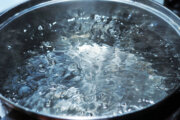Are you wearing your face mask? Good for you. If there is one way we all can help slow the spread of the novel coronavirus and COVID-19, it’s by properly wearing a mask to cover the nose and mouth whenever we go out in public –and, of course, maintaining 6 feet of social distance, too.
Does wearing a mask annoy you? Of course it does. No one likes it. Especially now, during the hot, humid, sweaty summer months. But with cases spiking in at least 40 states as of early July, we are quickly losing whatever ground we made up in recent months of the pandemic — mainly because too many people refuse to wear masks and stay away from others.
But experts say now is not the time to let a little discomfort put you and others at risk for this serious and often fatal disease. “To be blunt, to say that you don’t want to wear a mask because it’s hot out even though it protects other people from you is like saying you are making chicken sandwiches for your church group, but you’re not going to cook them through,” says Dr. Michael Bell, deputy director of the Centers for Disease Control and Prevention’s Division of Healthcare Quality Promotion.
[Read: How to Make an Effective Face Mask.]
So if the summer heat has you thinking about ditching your mask, consider the following strategies to keep you cool while still fighting COVID-19.
If it’s too hot, stay home. “I’m in the Southern heat, and my nose and mustache get a little sweaty, but it’s not awful,” Bell says from CDC headquarters in Atlanta. “From my perspective, in preventing harm to other people, if it’s too hot, maybe you should not go out.” At the very least, avoid being outside during the hottest part of the day, and go out earlier in the morning or after the sun goes down in the evening.
Stay socially distant. If you have to be out in the afternoon heat, rethink how you are working or interacting with others, and stay the appropriate distance away from others in cases where you’re unable to put on a mask.
Try a thinner mask. Many do-it-yourselfers are making their own masks, and the American Quilter’s Society recommends a few changes during summer. “Most quilters are only using two layers of fabric for the summer months, instead of three,” says Bonnie Browning, executive show director for the AQS. Many of the mask patterns use three layers and a layer of interfacing, but, “A mask can be made with only two layers and still have an opening at the bottom to insert a filter if needed. This would still give protection and be cooler for most people,” she says.
Use breathable materials. Cloth masks are best in the summer months because polyester and synthetic fabrics trap heat, causing sweat to build up on the wearer’s faces, Browning says. She also recommends choosing light-colored fabrics, which reflect the sun’s rays, instead of dark colors, which absorb heat.
[Read: Do Face Masks Work? Types and Effectiveness]
Loosen your mask — a bit. If it’s hard to breathe, and you can easily maintain social distance, create more space between your face and mask, Bell says. It still needs to cover your nose and mouth, but even if it’s not as snug as normal, it will still block most of your water droplets and keep others safe. If you are in a crowd, however, pull your mask tight again until you are away from others.
It doesn’t have to be perfect. “We’re not looking for perfection by any stretch. We want that 80 to 90% benefit,” Bell says. “I’ve seen many different things that accomplish the goal of covering the nose and mouth. I’ve seen a hybrid bandana-type thing that hangs below the chin that does a nice job. Don’t overthink the, quote, ‘filtration’ side of things. That’s not what we are trying to do here. We are really trying to block a lot of things, not everything.”
Bring an extra mask or two. If your mask gets sweaty and heavy, not only is it more uncomfortable, it also becomes harder to breathe through. Have a spare or two on hand if you plan to be outside for so long that your first mask becomes unusable.
[See: What Are the Symptoms of Coronavirus?]
If you cannot breathe easily, take it off. It’s easy to overheat in the summer, and breathing is one way our bodies cool down. If you are laboring to breathe, you feel lightheaded, your heart is beating too fast or you are sweating profusely — or not sweating at all, which is a sign of heat exhaustion — find a cool place where you can be 6 feet from others and take the mask off. Get water as fast as you can. And if you don’t feel better in a few minutes, call 911, as you may be suffering heat exhaustion or heat stroke, which can be life-threatening.
If you have a lung disease, avoid the heat. Summer heat can make chronic respiratory illnesses like asthma, severe allergies and COPD worse. Be aware of your breathing, and if it seems to be getting worse in the heat, stay indoors. “Don’t put yourself at risk with a face covering,” Bell warns.
Remember, wearing a mask isn’t so much about protecting yourself as it is about protecting others. “It’s easy to get tired of this,” Bell says, “but it’s one of things we have to do as adults and good citizens.” Even in summer.
More from U.S. News
Coronavirus Prevention Steps That Do or Do Not Work
How to Wear a Face Mask Safely and Comfortably in Summer originally appeared on usnews.com






